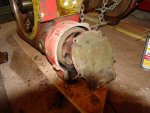To clarify my 2011 post: I was pulling 1400 feet of 1" sidewall, 30" diameter PE welded pipe through a basic square concrete storm sewer that was only 4'x4'. When we got the 1st pipe through we had to pull a second one through the same sewer box, all 1400 feet under the city of Amsterdam, NY. I was on a 4 part line with the 45,000 pound drag winch with ground spades imbedded in frozen ground and giant full dual width drive on chock blocks. I could not use 4th gear ay 1100 rpms as trained. went as low as second gear at 1500 rpms. It constantly lifted the wrecker off the blocks as the pipe would hang up in the hole, then settle fast when the pipe started moving again. Guess I was really using the winch all the way. Also, the drag winch on an M543A2 uses a steel shear pin that is partly cut at 2 points where it passes from yoke to shaft and back to yoke. JT




